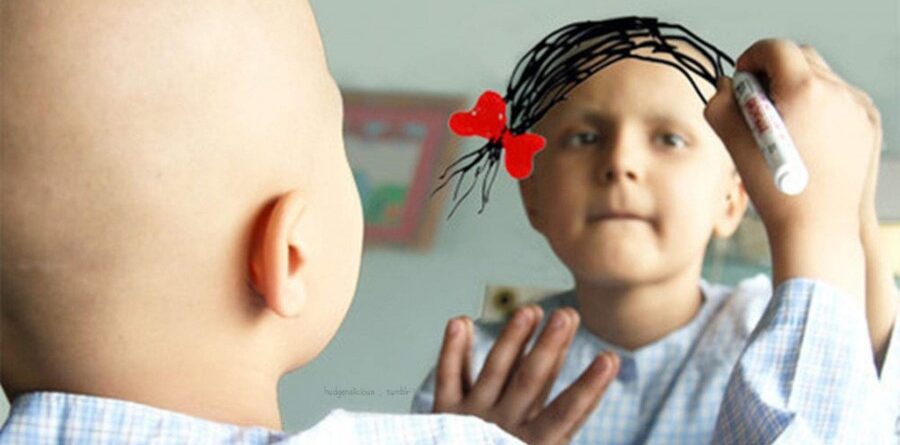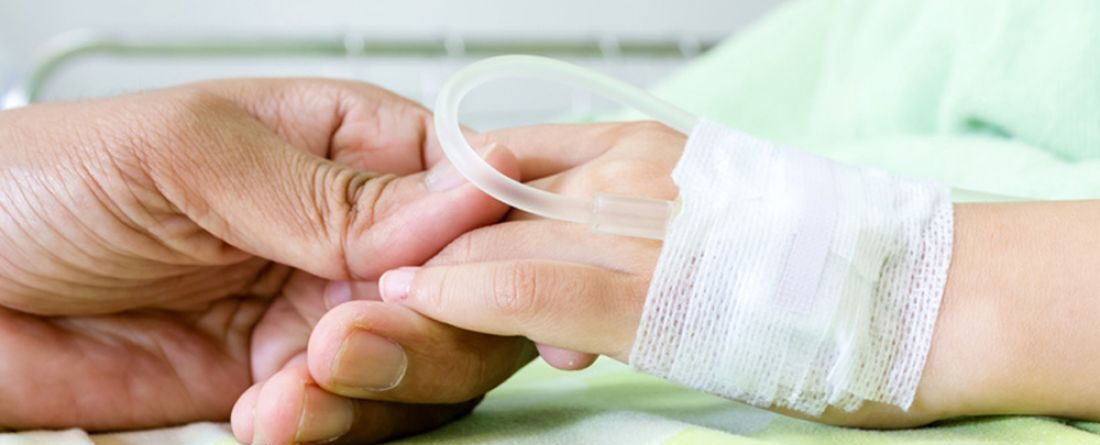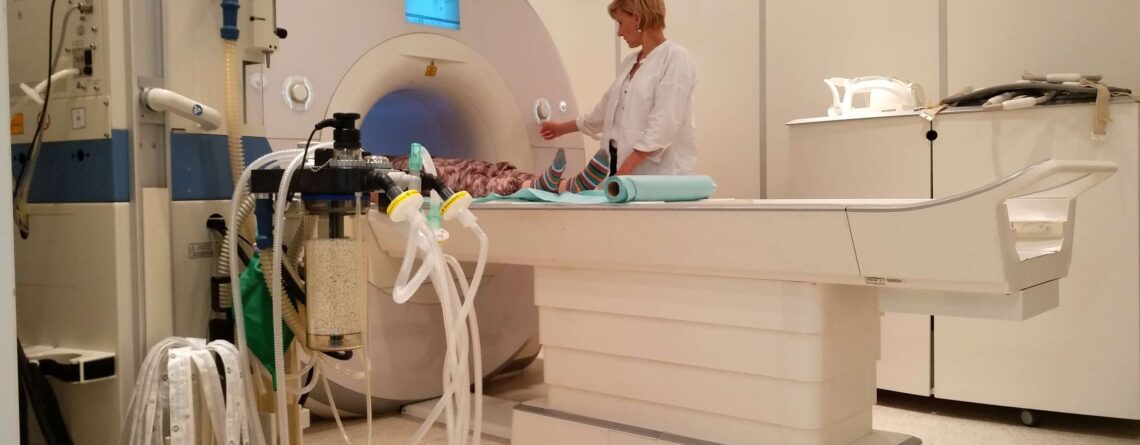Atypical teratoid-rhabdoid tumor (ATRT) is a rapidly progressing embryonal tumor of brain and spinal cord. ATRO is very rare: it accounts for about 1–2% of central nervous system (CNS) tumors in childhood. Most often, such tumors occur in children under 3 years of age. Approximately 50% of embryonal tumors in infants under 1 year of age are ATRT. In USA, 75 new cases of the disease are registered annually.
Most often, such tumors develop in cerebellum and brain stem. ATRT is an aggressive and fast-growing tumor. Treatment usually involves a combination of several methods, including surgery, chemotherapy, and radiation therapy. Even using modern methods of therapy, this disease is quite difficult to treat and has a serious prognosis.

If your child is diagnosed with ATRT or there is a suspicion of this disease – do not delay! Urgently contact a doctor who has not only theoretical training, but also practical experience in managing patients with such tumors. These are doctors who work in Oncology Department of Maimonides Multidisciplinary Medical Center. Our clinic functions according to Israeli medicine model, as one of the most effective in the world, and we also work in close cooperation with the best Israeli children's oncology centers. Each individual clinical case is jointly managed by the attending oncologist, the head of department and responsible oncologist directly from Israel. Thanks to such coordinated work of a professional team, we manage to achieve success even in the most difficult situations.
Maimonides Clinic works under the patronage of “Keren Or for our Child” the Charitable Foundation, so all our patients, especially children with cancer, have the opportunity to receive financial assistance that partially or fully covers necessary treatment course.
Our specialists have appropriate theoretical training and necessary practical experience in managing patients with brain tumors, including ATRT. Most of them have repeatedly completed internships at the best children's oncology clinics around the world. In their practical activities, our doctors are guided only by modern clinical recommendations and global treatment protocols, so quality of medical services provision cannot be doubted. However, the approach to each patient is individual. Making up a treatment plan, specialist does not use a one template, but takes into account all important points both from the side of child and his health, and from the side of tumor and its characteristics. This makes it possible to create the most effective personalized treatment scheme for each individual child, which in future only positively affects long-term prognosis.
A multidisciplinary approach is an indisputable advantage of ATRT tumor treatment at Maimonides Medical Center. One patient with a brain tumor is immediately assisted by a whole team of narrow specialists – oncologists, neurologists, neurosurgeons, radiation therapists, chemotherapists, rehabilitation specialists, psychologists and other specialists if necessary. Thus, in one institution, you can get all necessary medical procedures, starting from diagnostic stage, ending with complex treatment and necessary amount of rehabilitation measures. Most of necessary manipulations can be obtained within Ukraine. If certain rare diagnostic equipment or a narrow specialist is not available, patient, with consent of parents, is directed to subsidiary medical centers or Israeli partner clinics, where all necessary medical services are guaranteed to be provided.

Causes and symptoms of ATRT
Most tumors of this type occur in children aged 3 years and younger. However, they can also occur in older children and young adults. Malignant rhabdoid tumors are closely related to tumors that occur in other parts of the body, such as kidneys (rhabdoid tumor of kidney).
In approximately 95% of cases , ATRO is associated with a gene that does not function properly. This gene, called SMARCB1, is a tumor suppressor gene. Less than 5% of ATRT cases develop due to a defect in another tumor suppressor gene called SMARCA4. These suppressor genes usually produce a protein to stop tumor growth. When gene is disrupted, protein is not produced and tumor growth is not controlled. This gene change can be congenital (germinal mutation) or occur only in tumor cells. Basically, gene mutation occurs only in tumor cells. However,all patients with rhabdoid tumors should be screened for gene mutations and consulted by a geneticist.
Malignant rhabdoid tumors share a common abnormal gene: a mutation in SMARCB1 gene (other names: INI1, SNF5, and BAF47). Sometimes a malignant rhabdoid tumor is caused by mutation in SMARCA4 gene. 15–30% of children have this mutation in every cell of the body (germline mutation). Most often, gene mutation occurs only in tumor tissues. It is important for families of patients with rhabdoid tumors to undergo genetic testing and counseling.Children with a germline mutation of these genes have an increased risk of developing rhabdoid tumors.
Symptoms of ATRT vary widely, depending on child’s age and tumor location. These tumors grow quickly and worsening symptoms can occur in a very short period of time.
Possible symptoms of ATRT:
- Headaches that are often worse in the morning and/or go away after vomiting.
- Nausea and vomiting.
- Changes in the level of activity, weakness.
- Increased fatigue or drowsiness.
- Loss of balance, coordination, or trouble walking.
- Asymmetry of eye or face movements.
- Changes in behavior, irritability.
- Head size increase in babies.
- An increase in size of parietal lobe (the soft area at the top of skull) in infants.
In case of any changes in child's health – do not delay! Ask for professional help, and qualified specialists of Maimonides Center will help you to deal with any situation quickly and efficiently.

ATRT diagnostic methods
Maimonides Clinic uses only modern diagnostic equipment of an expert class, thanks to which diagnostic process becomes surprisingly comfortable and accurate.
A medical history and a thorough physical examination help doctors learn about symptoms, general health, past medical conditions, and risk factors.
Genetic testing and counseling are also recommended for patients with ATRT. A study of SMARCB1 and SMARCA4 genes of patients with suspected ATRO and their close relatives is being conducted.
During neurological examination , functions of brain, spinal cord and cranial nerves are assessed. During examination, various aspects of brain function are checked: memory, vision, hearing, muscle strength, balance, coordination and reflexes. Already after this examination, an experienced neurologist can tell which part of brain is affected, that is, where exactly neoplasm is located.
Using diagnostic imaging, such as magnetic resonance imaging (MRI), detailed images of brain and spinal cord are obtained. Doctors can see the size and location of tumor and better understand which areas of brain are affected. Imaging, ATRT can be similar to other tumors, so further examinations are necessary for diagnosis.
To search for malignant cells in cerebrospinal fluid, a lumbar puncture can be performed with subsequent cytological analysis of obtained cerebrospinal fluid.
A biopsy is performed to biopsyconfirm ATRT diagnosis. In a biopsy, a small sample of tumor is removed with a needle during surgery. Pathologist examines a tissue sample under microscope to determine the type of tumor. ATRT cells differ from healthy cells. Cell markers in tissue are used to study specific proteins in cells. To determine SMARCB1 or SMARCA4 protein in cancer cells, specific staining with antibodies (immunohistochemical study) is used. This protein is absent in ATRT cells, which confirms tumor diagnosis.
One of tests that makes it possible to evaluate possible genetic changes in tumor cells is Foundation One comprehensive tumor genomic profiling.This is a line of genetic tests for individual selection of targeted cancer treatment. These are the only tests approved for use by FDA (US Food and Drug Administration). Foundation One's research is based on an in-depth analysis of tumor genome, allowing to discovery of clinically relevant mutations and potentially expanding therapeutic options for each patient.
After biopsy, we send all materials for revision to the best pathogistological laboratories in world (Israel, USA, Germany), where they are reviewed by a qualified specialist. Thanks to such double checks, we are absolutely sure of diagnosis correctness and subsequent selected treatment tactics.

Forecast at ATRT
There is no standard system for determining the stage of ATRT development. Tumors are classified as newly diagnosed or recurrent. ATRT is an aggressive type of cancer . Approximately 15-30% of patients are diagnosed with spread to membranes of brain or cerebrospinal fluid. This spread of the disease to membranes of brain is called leptomeningeal metastases.
ATRT is a rapidly progressing and difficult curable tumor. The prognosis is usually unfavorable, but application of new advances in the field of treatment helps some patients to overcome the disease.
Forecast is influenced by following factors:
- Age of the child. For children under 3 years prognosis is less favorable.
- Whether tumor has spread to other parts of brain or spinal cord or at the time of diagnosis.
- What part of tumor remained after surgical intervention. Complete resection of tumor increases the possibility of successful treatment.
5-year survival for children with ATRT is approximately 50%. However, this value varies greatly, depending on age at the time of diagnosis and presence of metastases. Children under 3 years age with metastasis have the least favorable prognosis.
Children with ATRT and germline mutations of SMARCB1 or SMARCA4 have predisposition syndrome to rhabdoid tumors. They and their family members should undergo genetic testing and counseling because their risk of developing other tumors is increased. Such children need additional monitoring with periodic ultrasound examination of kidneys.
Undergoing treatment with ATRT children should be observed for side effects of treatment. Long-term effects may include neurocognitive and endocrine disorders due to exposure. Chemotherapy and radiation therapy also increase the risk of secondary cancers. Patient's family should consult their doctor about the risks associated with treatment methods prescribed for child.
Children with brain tumors should be treated only by specialists from clinics with a specialized Pediatric Oncology and Neurosurgery Department. Maimonides Medical Center is just such a medical institution. We employ highly qualified specialists who have modern comprehensive treatment programs. The aim of any therapy program is to cure the child in the most gentle manner and at the same time minimize risks of possible side effects during treatment and long-term consequences after its completion.
Modern treatment of ATRT
Treatment depends on several factors, including the size of tumor, its location, and child's age. ATRO is a very aggressive cancer, and for most patients, several treatment methods are used (complex approach). Treatment for ATRO usually includes surgery, chemotherapy, and radiation therapy. Often treatment of this disease is also carried out as part of clinical trials.
A surgical intervention is performed both for diagnosis and for treatment of ATRT. If ATRT is confirmed by biopsy, surgeon will remove as many tumor cells as possible. Such tumors are often difficult to remove completely due to their location in brain and rapid spread to other areas. But thanks to a professional team of pediatric neurosurgeons, surgeries to remove a rhabdoid tumor are performed with great success. ATRT removal is performed under control of the world's most powerful KINEVO medical microscope and an innovative intraoperative MRI device. As a result, neurosurgeon better controls course of surgery and does not make mistakes. Removing ATRO located near important nerve nodes, an awake craniotomy is performed , or a surgery during which patient remains fully conscious.
In treatment of ATRT, along with surgery and/or radiation therapy, chemotherapy chemotherapy is often used. Chemotherapy can be systemic, regional or intrathecal. High-dose chemotherapy is also used to treat this type of cancer.
In high-dose therapy, patient is initially given very high doses of chemotherapy drugs in order to 100% destroy all malignant cells. A side effect of such treatment is a negative effect on healthy body cells, in particular, bone marrow cells. This leads to cessation of its functioning, which is incompatible with life. Therefore, the next stage of such patients is an autologous transplantation of hematopoietic stem cells, which were taken from patient before the start of chemotherapy. In modern Israeli oncology centers, bone marrow transplantation is carried out in a full cycle (3 transplantations) for a better prognosis, which makes it possible to obtain incredible results of such combined treatment and help hundreds of patients with ATRT.
As part of ATRT complex treatment, radiation therapy is also used on modern linear accelerators with IMRT function (simulation of ionizing radiation dose intensity). IMRT is the modern standard of radiation treatment for oncological diseases, during which high doses of ionizing radiation are delivered precisely inside the tumor, while healthy brain tissues remain protected from radiation.
Children with ATRT can participate in clinical trials using targeted therapy. These treatment methods are used for newly diagnosed tumors or recurrences. Targeted therapy drugs include aurora A kinase inhibitor alisertib and EZH2 inhibitor tazemetostat. Immunotherapy application is also being studied during treatment of ATRT.
In each individual case, the decision on combination of certain treatment methods is made jointly by a team of specialists. Thanks to this approach, we manage to achieve a high rate of patient survival, even in the most difficult cases. For treatment of diffuse intrinsic pontine glioma, narrow-profile experts are involved, who closely interact with each other. Constant communication allows us to quickly and effectively make decisions on adjusting treatment regimen, if there is an urgent need for this, to monitor the results of surgery and the health status of our small patient.
